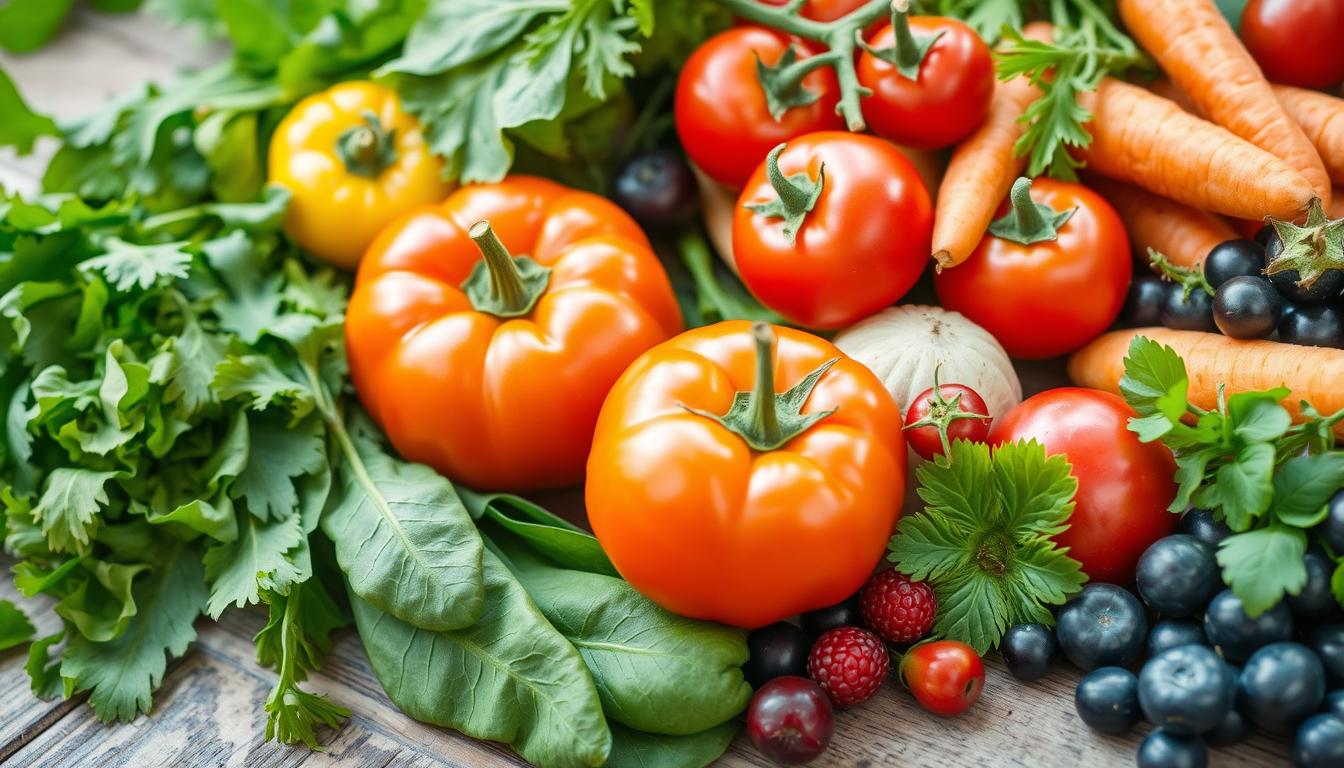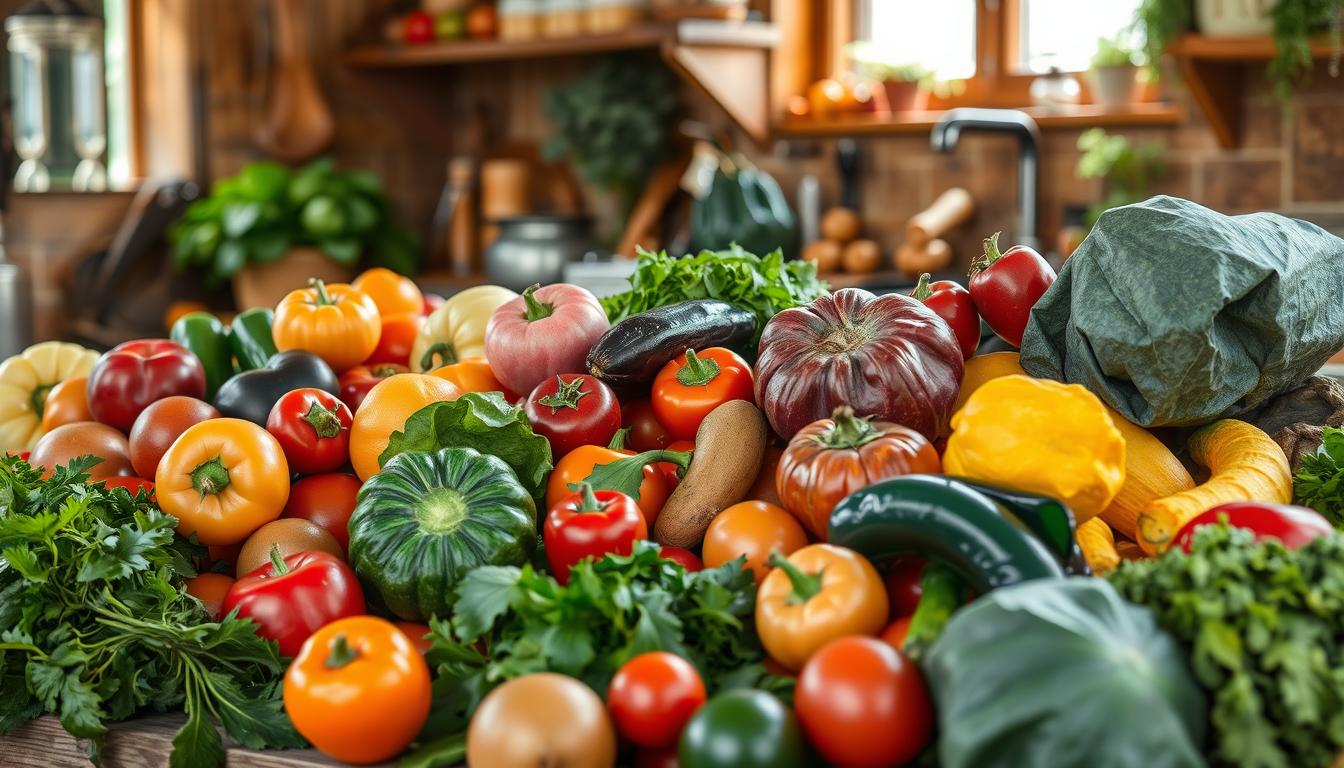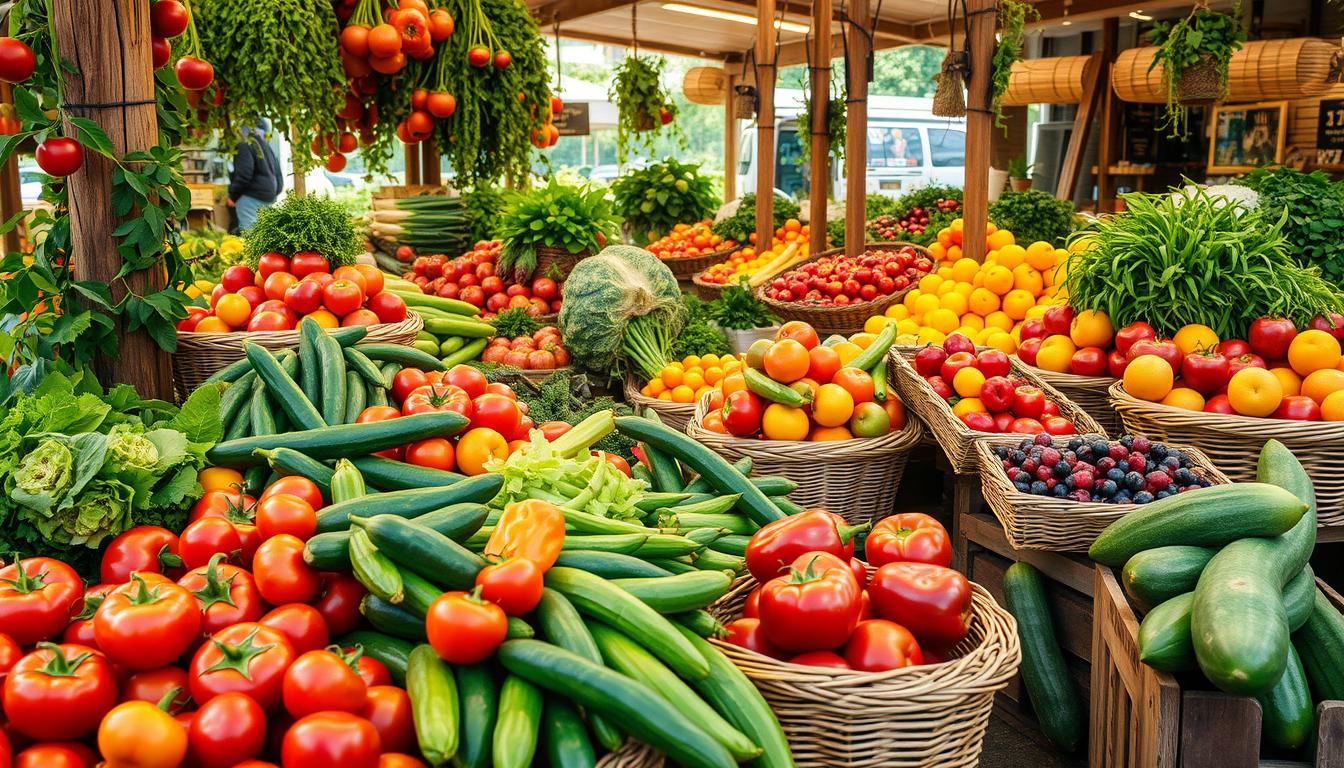Did you know the average American eats over 150 pounds of synthetic additives yearly? These artificial substances in our processed foods can harm our health. But, more people are choosing natural foods without these additives. Welcome to pure eating, where we focus on whole, unaltered ingredients that are good for us and taste great. In this guide, we’ll explore natural foods deeply. We’ll look at the big differences between synthetic and natural additives. We’ll also talk about the benefits of clean labels and how to switch to a healthier diet. This article is for anyone looking to make better food choices and enjoy the benefits of eating pure, unprocessed foods. Key Takeaways The average American consumes over 150 pounds of synthetic additives per year, which can have significant health impacts. Natural foods without synthetic additives offer a range of benefits, including improved nutritional value, enhanced flavor and freshness, and better digestive health. Understanding the different types of synthetic additives and their associated health risks is crucial for making informed purchasing decisions. Identifying natural ingredients, recognizing trustworthy certifications, and supporting local farms and farmers’ markets are key strategies for incorporating more natural foods into your diet. Gradual changes, stocking your pantry with natural alternatives, and meal planning can help you successfully transition to a diet free from synthetic additives. Understanding Synthetic Additives and Their Impact Choosing healthier foods means knowing about synthetic additives. These man-made ingredients add flavor, color, or extend shelf life. But, they can affect our health. Let’s look at synthetic additives, their types, and health risks. What Are Synthetic Additives? Synthetic additives are chemicals made in labs for food. They help keep food fresh, change texture, or taste better. Foods labeled additive-free, preservative-free, non-GMO, and organic aim to use fewer of these. Common Types of Synthetic Additives Processed foods often have these synthetic additives: Artificial preservatives, like sodium benzoate and BHA, to keep food fresh Synthetic colors, such as FD&C Red No. 40 and Yellow No. 5, for looks Artificial sweeteners, like aspartame and saccharin, for sweetness without calories Flavor enhancers, like MSG, to make flavors stronger Health Risks Associated with Additives While additives are safe in small amounts, their long-term effects worry many. Research links some additives to health problems, including: Allergic reactions and sensitivities Disrupting hormonal balance Higher risks of obesity and heart disease Possible cancer risks Choosing additive-free, preservative-free, non-GMO, and organic foods reduces our exposure. This can lead to better health and well-being. “The fewer artificial ingredients in our food, the better – for our bodies, our communities, and our planet.” Benefits of Choosing No Synthetic Additives Choosing foods without synthetic additives opens up a world of benefits. These natural ingredients and whole foods improve our nutrition and taste. They also help our digestion. Improved Nutritional Value Processed foods with synthetic additives are avoided. This lets us get all the vitamins, minerals, and antioxidants from nature. Natural foods like fruits, veggies, and proteins keep their nutritional power. Enhanced Flavor and Freshness The flavors of whole foods are unmatched. They offer vibrant tastes and freshness. Each bite is full of natural goodness, pleasing our senses and nourishing our taste buds. Better Digestive Health Many synthetic additives can harm our gut health. Choosing unadulterated foods helps our digestive system. They provide fiber and nutrients that support a healthy gut. Eating pure, natural foods is not just a health trend—it’s a timeless way of nourishing our bodies the way nature intended. By choosing pure, unadulterated whole foods, we gain many benefits. We enjoy nature’s flavors and support our health and energy. Identifying Natural Foods Choosing healthier options can seem hard with all the labels out there. But don’t worry, we’re here to help. We’ll show you how to find natural foods without synthetic additives. You’ll learn to read labels and spot trustworthy certifications, making it easier to pick clean, additive-free products at the store. Reading Labels: What to Look For Start by carefully reading the label. Avoid products with artificial colors, flavors, or preservatives. Instead, look for simple, easy-to-pronounce ingredients. Stay away from long lists of chemical-sounding words, as they often mean synthetic additives to watch out for. Recognizing Natural Ingredients Choose foods with whole, plant-based ingredients like fruits, vegetables, grains, and nuts. Opt for products that are non-GMO and organic whenever possible, as these are less likely to contain synthetic additives. Look for items that boast a “clean label” – meaning they have minimal, natural ingredients without any artificial or hard-to-pronounce additions. Trustworthy Certifications and Brands To find additive-free foods, look for reliable certifications like USDA Organic, Non-GMO Project Verified, and additive-free labels. These third-party seals of approval show brands that offer clean, natural products. Brands like Whole Foods, Patagonia Provisions, and Annie’s Homegrown are known for their commitment to natural ingredients. Certification What it Means USDA Organic Indicates the product is made with certified organic ingredients, without synthetic pesticides, fertilizers, or additives. Non-GMO Project Verified Ensures the product has been rigorously tested and confirmed to be free of genetically modified organisms (GMOs). Additive-Free Signifies the product contains no artificial colors, flavors, or preservatives, only natural ingredients. By following these tips, you’ll be able to find and enjoy the natural,additive-freefoods your body needs. Popular Natural Food Brands Exploring the world of natural foods is exciting. We highlight beloved brands like Organic Valley, Whole Foods Market, and Annie’s Homegrown. They make it easy to eat foods with natural ingredients. Organic Valley Organic Valley leads in natural foods, offering preservative-free and no synthetic additives dairy products. Their milk, yogurts, and cheese are all about clean ingredients. They support local communities and the environment, focusing on natural ingredients. Whole Foods Market Whole Foods Market is a top choice for natural and organic foods. They have a wide range of preservative-free and no synthetic additives options. From fresh produce to prepared meals, they aim for quality and transparency. Annie’s Homegrown Annie’s Homegrown is loved for its family-friendly foods. They offer preservative-free macaroni and cheese, snacks, and baking mixes. Known
Top Ways to Enjoy No MSG Food for Natural Dining
Did you know 75% of Americans try to avoid MSG in their meals? This has changed the food industry, leading to more natural, MSG-free choices. Let’s dive into the best ways to enjoy no MSG food and make dining healthier and more enjoyable. Key Takeaways Understand what “no MSG” means and its impact on your health Discover trusted brands and labels that offer MSG-free products Learn tips and tricks for preparing delicious no MSG meals at home Explore a variety of no MSG recipes, from breakfast to dinner Uncover strategies for finding and enjoying no MSG options when dining out Download Food Scan Genius to help you on your making choices of products you buy. Understanding No MSG: What It Means for Your Health We’re all looking for food that’s good for us. This means finding options without preservatives or allergens. Monosodium glutamate, or MSG, is a big topic. So, what does “no MSG” mean, and how can it help us stay healthy? The Science Behind MSG Sensitivity MSG is a flavor booster found in many foods, even some we think are healthy. Some people might react to MSG, but research is not clear. Many studies say MSG is safe in small amounts. Any bad effects might depend on how our bodies react differently. Common Myths About MSG Myth: MSG is a harmful, artificial additive. Fact: MSG is a natural compound in foods like tomatoes, cheese, and seaweed. Myth: MSG causes headaches and other health problems. Fact: Some might feel sensitive, but science doesn’t link MSG to big health issues. Health Benefits of Avoiding MSG Staying away from MSG can be good for those who are sensitive or prefer natural foods. Choosing MSG-free foods might help with digestion, headaches, and overall feeling better. It also means eating more natural, whole foods, which are better for you. Whether to avoid MSG is up to you. Knowing the facts about MSG sensitivity helps us make better food choices. This way, we can focus on our health and well-being for the long run. Popular No MSG Brands to Try If you want to avoid MSG and live a healthier life, you’re in the right place! There are many trusted brands that offer no-MSG products. You can find everything from organic pantry staples to tasty snacks that are MSG-free. Identifying Trusted No MSG Labels When shopping, look for labels that say “MSG-Free,” “No MSG Added,” or “Certified MSG-Free.” These labels mean the product doesn’t have MSG. Also, check for Non-GMO Project Verified or USDA Organic labels. They show the product is made with pure, unprocessed ingredients. Top Organic Brands Without MSG Amy’s Kitchen: Offers organic, MSG-free canned meals and frozen entrees. Cascadian Farm: Provides a wide range of organic, non-GMO cereals, snacks, and frozen produce without MSG. Lundberg Family Farms: Makes organic, unprocessed rice products like rice cakes and chips, all MSG-free. Snack Options: Delicious No MSG Choices For a healthy snack, try roasted nuts, fresh fruit, or veggie-based chips. Brands like Beanfields, Kettle Brand, and Late July Snacks make these options. They focus on using unprocessed, MSG-free ingredients for snacks that are both tasty and healthy. Brand Product Category MSG-Free Certification Amy’s Kitchen Canned meals, frozen entrees No MSG Added Cascadian Farm Cereals, snacks, frozen produce Non-GMO Project Verified Lundberg Family Farms Rice products, rice cakes, rice chips USDA Organic Beanfields Veggie-based chips Certified Gluten-Free, Non-GMO Kettle Brand Potato chips No MSG Added Late July Snacks Organic snacks USDA Organic, Non-GMO Project Verified Exploring these no-MSG brands lets you enjoy tasty snacks and meals without worrying about MSG’s health risks. Choose products with natural flavors and nourishing ingredients to support a healthier lifestyle. No MSG Meal Preparation: Tips and Tricks Making tasty, MSG-free meals at home is simpler than you might think. Use fresh, natural ingredients and try different herbs and spices. This way, you can make many delicious dishes without artificial additives like MSG. Let’s look at some tips and tricks for cooking without preservatives. Using Fresh Ingredients for Flavor The key to great MSG-free meals is using top-quality ingredients. Choose fresh, whole foods for their natural taste and nutrients. Seasonal, local produce is best for freshness and flavor. Pair these with good proteins like lean meats, fish, or plants for a full meal. Herbs and Spices That Enhance Taste Try different herbs like basil, oregano, and thyme for depth in your dishes. Spices like garlic, ginger, and cumin can really boost your food’s flavor. Look for seasoning blends without MSG or artificial additives to let the natural flavors stand out. Cooking Techniques for MSG-Free Meals Use various cooking methods to enhance your ingredients. Roasting, grilling, or pan-searing can make foods sweeter and more flavorful. Slow-cooking, like braising, helps mix flavors well. Also, try using different liquids like broth or wine to add more taste to your dishes. Cooking Technique Benefits for MSG-Free Meals Roasting Caramelizes natural sugars for deeper flavors Grilling Adds a smoky, charred essence to ingredients Braising Develops and melds flavors over time Simmering Allows natural ingredients to infuse the dish By using fresh ingredients, herbs, spices, and various cooking methods, you can make many tasty MSG-free meals. These meals will please your taste buds and be good for your health. Delicious No MSG Recipes to Try at Home Eating without MSG doesn’t mean you have to miss out on taste. We’ve put together a list of tasty, healthy recipes without artificial additives like MSG. These dishes, from energizing breakfasts to filling dinners, are free from allergens and are full of wholesome ingredients. They’re sure to delight your taste buds and impress your family and friends. Breakfast Ideas Free from MSG Begin your day with a nutritious meal from our MSG-free breakfast options. Try a veggie-packed frittata, a fresh fruit and yogurt parfait, or a quinoa breakfast bowl. These meals are packed with nutrients and will give you the energy to start your day off right. Spinach and Feta Frittata Overnight Oats with Berries and Nuts Quinoa Breakfast
No GMOs: Your Guide to Natural Food Choices
Our food choices greatly affect our health and the planet. It’s time to learn about the benefits of non-GMO products. We’ll look into the science of genetic modification, GMO crops’ history, and their use today. You’ll gain the knowledge to make better food choices. What if the foods we eat could harm us without us knowing? We’ll dive into GMOs and why choosing non-GMO is key for our health and the planet. You’ll discover how to choose a more natural, sustainable food path. Key Takeaways Discover the science behind GMOs and their impact on food production. Explore the benefits of choosing non-GMO products in your diet. Learn how to identify and avoid GMO ingredients through effective food labeling. Discover natural alternatives to GMO products and support sustainable agriculture. Understand the connection between organic farming and non-GMO foods. Understanding GMOs and Their Impact on Food Production Genetic modification, or genetic engineering, changes the genetic makeup of living things, like food crops. Scientists can add traits like more yield, pest resistance, or better nutrition. But, this technology also raises questions about its effects on the environment and health. The Science Behind Genetic Modification Genetic engineering involves finding and adding specific genes to another organism’s DNA. This can be done with plants, animals, or microorganisms. The aim is to create new life forms with special traits. For farming, it’s used to make crops more resistant to pests, diseases, and harsh weather. Historical Development of GMO Crops The first GMO crop, a tomato, was approved in the U.S. in 1994. Since then, GMO use in farming has grown. Now, crops like corn, soybeans, and canola are mostly GMO. This has raised concerns about its environmental impact. Current GMO Statistics in Agriculture In 2019, about 190.4 million hectares of land worldwide were used for GMO crops. The U.S. leads in GMO crop production, with 71.5 million hectares in 2019. Brazil, Argentina, Canada, and India are also big GMO producers. The most modified crops are soybeans, corn, cotton, and canola. As GMO use in farming grows, understanding its science and effects is key. It’s important for sustainable agriculture and the environment. Benefits of Choosing No GMOs in Your Diet More people are choosing non-GMO foods as GMO awareness grows. This choice is good for health and the environment. It’s a step towards a better lifestyle. Non-GMO diets may be healthier. Some research links GMOs to health problems like allergies and chronic diseases. By avoiding GMOs, you might avoid these risks and eat better. Choosing non-GMO also supports organic farming. Organic farming avoids harmful chemicals. This choice helps the planet and our health. Non-GMO foods are often more natural. They are less processed and closer to their natural state. This means better taste and nutrition. Choosing non-GMO food is not just about personal health – it’s about supporting a food system that is better for the planet and future generations.” – Jane Doe, Organic Farming Expert More people want to know where their food comes from. Non-GMO choices are becoming more appealing. They help create a healthier, more sustainable food system. Potential Health Benefits of Non-GMO Environmental Advantages of Non-GMO Reduced risk of allergies and digestive issues Minimized exposure to potential long-term health concerns Promotion of a more natural, whole-food-based diet Alignment with organic farming practices Reduced use of synthetic pesticides and fertilizers Support for a more sustainable food production system How to Identify and Avoid GMO Products Understanding food labels can seem hard, but don’t worry! We’ll show you how to spot and steer clear of genetically modified (GMO) foods. You’ll learn to read labels well and use the Food Scan Genius app. This way, you can choose what you eat wisely. Reading Food Labels Effectively To avoid GMO foods, start by getting good at reading labels. Look for the non-GMO or organic seals. These mean the product doesn’t have genetically modified stuff. Also, watch out for GMO ingredients like corn, soy, canola, and sugar beets. Common GMO Ingredients to Watch For Corn and corn-derived ingredients Soy and soy-derived ingredients Canola oil Sugar beets Cottonseed oil Papaya Zucchini and yellow squash Using the Food Scan Genius App for GMO Detection For more confidence, try the Food Scan Genius app. It lets you scan barcodes and tells you if a product has GMOs. This app makes choosing non-GMO foods easy. The Food Scan Genius app has been a game-changer for my family. It takes the guesswork out of grocery shopping and ensures we’re avoiding GMO products with ease. Get to know food labels, know the GMO ingredients, and use the Food Scan Genius app. You’ll be on your way to a non-GMO life. Enjoy making smart choices and feeling sure about your food. Natural Alternatives to GMO Products Looking for a healthier lifestyle? Explore natural, non-GMO alternatives to common foods. You can change your pantry, enjoy tasty snacks, or try new drinks. Nature’s power is in every delicious option. Choosing non-GMO doesn’t mean giving up taste or convenience. There’s a wide range of non-non-GMO products. From organic farming to sustainable agriculture, they help nourish you and the planet. Pantry Staples: Rethinking the Essentials Replace processed and GMO foods with wholesome, non-GMO pantry staples. Try different non-GMO flours, grains, and legumes for tasty meals. Choose brands that focus on sustainable agriculture and organic farming for your daily needs. Snacks and Treats: Satisfying Cravings Naturally Enjoy non-GMO products without losing flavor. Find crunchy chips, savory dips, sweet treats, and baked goods without GMOs. Look for brands that use high-quality, non-GMO ingredients for guilt-free indulgence. Beverages: Quenching Thirst the Natural Way Stay hydrated with non-GMO drinks. Avoid sugary, artificial drinks and choose refreshing non-GMO juices, teas, and non-dairy milks. These options not only quench your thirst but also offer nutrients and health benefits without GMOs. Product Category Non-GMO Alternatives Key Benefits Pantry Staples Non-GMO flours, grains, legumes Whole, unmodified ingredients; support for sustainable agriculture and organic farming Snacks and Treats Non-GMO chips, dips, baked goods Satisfy cravings with natural,







